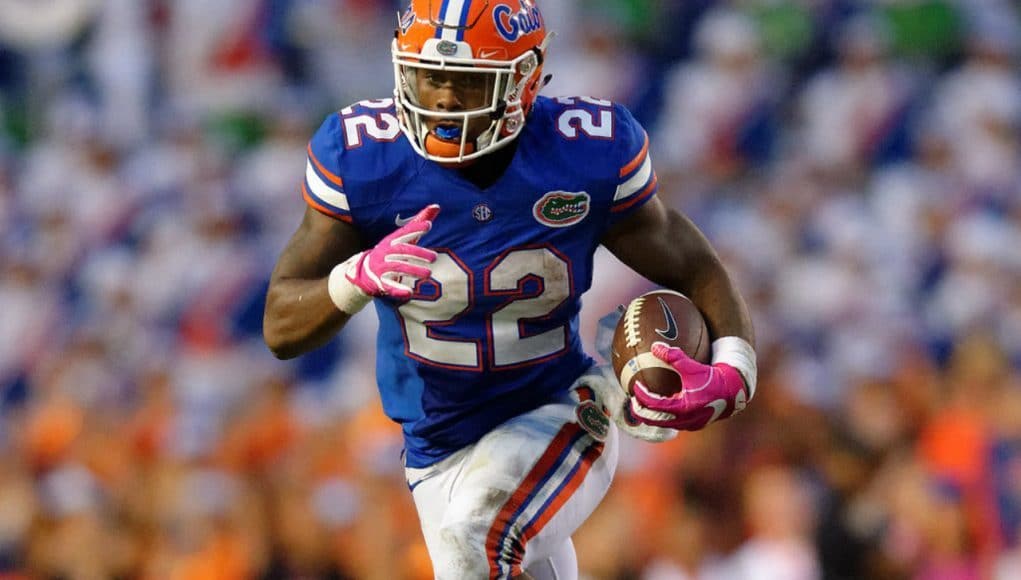The Florida Gators have a clear objective in their fight against the Missouri Tigers this weekend: play keepaway.
Mizzou has a high tempo offense that loves to throw the ball. Left up to its own devices, the Tigers’ offense would induce games that drag on over four hours with point totals in the 40s at least.
Florida’s defense has a chance to slow it down some, but Mizzou loves to throw deep. The young Gator secondary still has some coverage busts at times, and those will probably happen against the Tigers.
The key, then, is to not let that offense have too many chances. I think the Gators can limit those chances by throwing the ball as little as is necessary to have a functional offense.
The Florida passing game is so poor at this point that it’s easy to miss that the rushing game is actually doing quite well. It was easily the best part of the World’s Largest Outdoor Cocktail Party for the Gators last weekend.
When you take sacks out of the totals, UF ran for 229 yards on 36 carries for an average of 6.4 yards per rush. That is 52 yards more than the next-highest total any Georgia opponent has gotten, which was Mississippi State’s 177 yards.
It’s also easily the best per-carry rate, with MSU’s 4.4 per run being next-most. Notre Dame has one of the best non-triple option run attacks in the country, and the Irish managed a mere 79 non-sack yards for a 2.3 YPC rate at home against the Bulldogs.
It’s true that some of the running UF did came in garbage time after the game was long decided. The same is true for Mississippi State, as it lost 31-3 to UGA. Even so, the Gators had 111 yards on 21 carries for 5.3 YPC in the first half. Before the break, Lamical Perine had 71 yards on 10 carries and was never stuffed for no gain or a loss. He even broke nice runs of 11 and, as you’ll see here, 29 yards.
Antonio Riles executes a great pull from the right guard spot, while DeAndre Goolsby does a good job of sealing the edge on his pull. Even Kadarius Toney, who looked completely lost when trying to block earlier this year, holds up the other side of the lane for the ball carrier. Perine picked up in one play about 37% of the rushing yards UGA gave up to Notre Dame in an entire game.
Georgia has a terrific run defense, as it has held five of eight opponents to three yards per carry or less. Missouri, on the other hand, has a terrible run defense. Idaho is the only team it has held under 4.6 yards per carry this season. Auburn and Kentucky went for over five per rush, while Georgia was just shy of 7.5 per carry.
There is no reason why UF shouldn’t be able to run the ball well even with Malik Davis gone for the year. Perine is capable of handling a load, while Mark Thompson was up over six yards a carry against the Bulldogs.
Furthermore, the offensive line is much better at run blocking than pass blocking. When you combine pass attempts and sacks taken, Feleipe Franks has taken a sack on 13.2% of his drop backs. The true percentage is a little lower than that thanks to a few scrambles, but not by much. Not all of those are the line’s fault, of course, with Franks running into a few sacks this year. That fact is all the more reason to keep the pass attempts to a minimum.
There also is the factor that Randy Shannon has said that he’s giving Malik Zaire a chance to win the starting quarterback job. Zaire is a bit scattershot as a passer but is much stronger as a part of the running game. His mobility, if used properly, will make the run attack that much more dangerous.
If Florida can control the clock, it will pay dividends the whole game long. One consequence of Mizzou going fast is that, if you can stop them, they will go three-and-out fast too. A Gator offense that is grinding out long drives combined with a defense that can get some stops could mean the Tigers run fewer than ten plays in one of the quarters on Saturday. It’s no coincidence that in blowout losses to Purdue and Georgia, Mizzou only ran 52 and 49 plays, respectively, in the entire games.
A Tiger offense running a small number of plays then means the Tiger defense will be on the field an awful lot. It’s not a deep unit, so fatigue could easily come into play in the second half. At that point, running the ball would become that much easier.
The goal for what’s left of this season is to just get to a bowl. That way, the team can get some practice reps in December and give the new staff a chance to look on and evaluate things. The one and only thing that matters to that end is putting tallies in the win column. It doesn’t have to be pretty.
Just run, run, run, baby.


